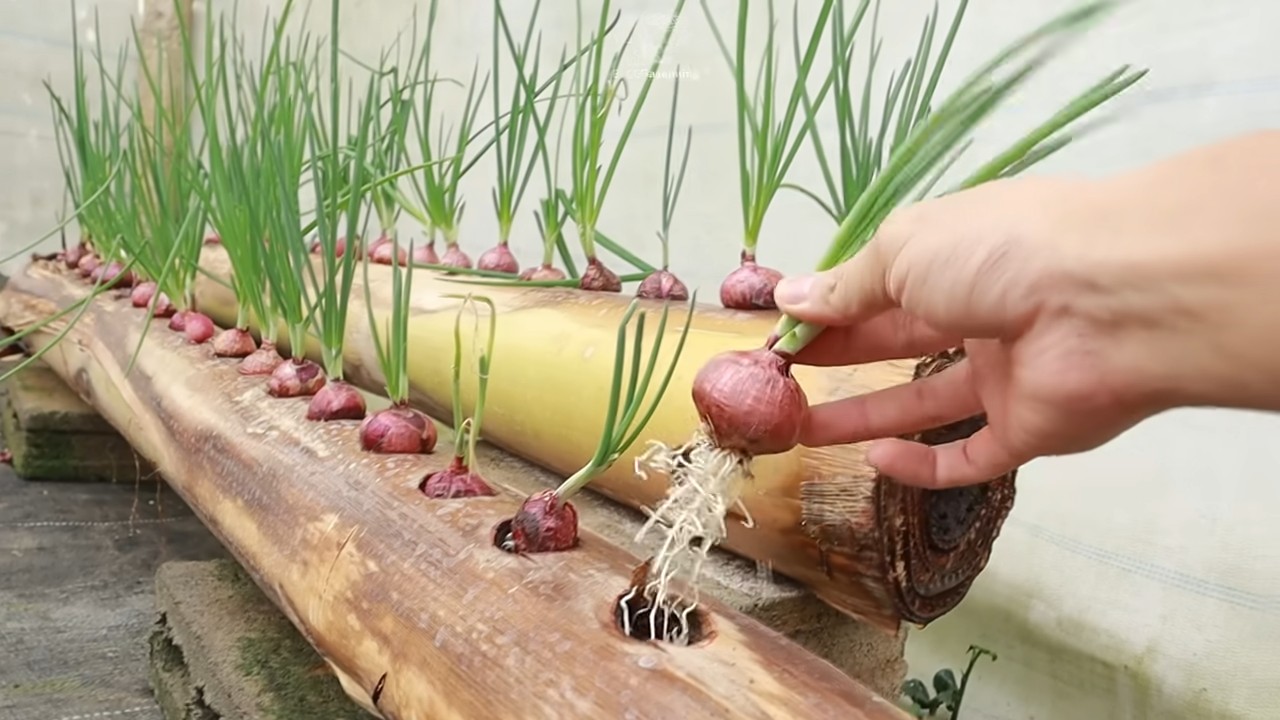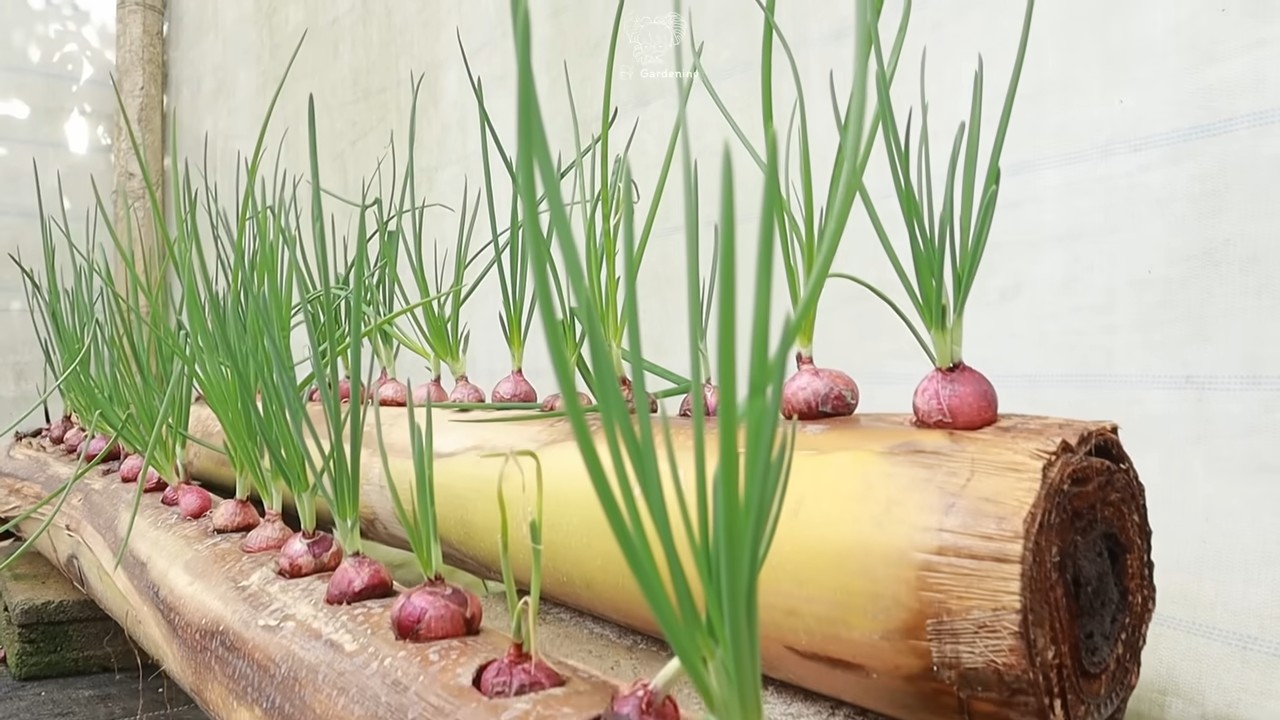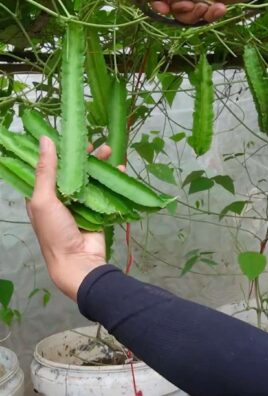Onion growing tips are your secret weapon to unlocking a garden overflowing with flavorful, homegrown goodness! Imagine plucking plump, juicy onions straight from your backyard, ready to elevate your favorite dishes. Forget those bland, store-bought onions – we’re talking about a culinary revolution, one bulb at a time.
For centuries, onions have been a staple in cuisines worldwide, dating back to ancient civilizations where they were revered for their medicinal properties and culinary versatility. From the pyramids of Egypt to the bustling markets of the Mediterranean, onions have nourished and flavored countless meals. Now, it’s your turn to tap into this rich history and cultivate your own onion bounty.
But let’s be honest, sometimes growing onions can feel a little intimidating. That’s where these DIY tricks and hacks come in! I’m here to share simple, effective strategies that will transform you from a gardening novice to an onion-growing pro. Whether you’re dealing with limited space, pesky pests, or simply want to maximize your yield, these onion growing tips will empower you to create a thriving onion patch, no matter your experience level. Get ready to impress your friends and family with your gardening prowess and enjoy the unparalleled taste of homegrown onions!

Grow Your Own Onions: A Beginner-Friendly Guide
Hey there, fellow gardening enthusiasts! I’m so excited to share my tried-and-true method for growing plump, delicious onions right in your own backyard. Forget those bland, overpriced onions from the grocery store – with a little patience and these simple steps, you’ll be harvesting your own flavorful crop in no time. Let’s get started!
Choosing Your Onion Type
Before we dive into the nitty-gritty, let’s talk about onion varieties. Choosing the right type for your climate is crucial for success. Onions are categorized by day length, which refers to the amount of daylight hours they need to form bulbs.
* Long-Day Onions: These are best suited for northern climates (above 36 degrees latitude) where summers have long days (14-16 hours of daylight). Popular varieties include Walla Walla Sweet, Yellow Spanish, and Red Burgundy.
* Short-Day Onions: These thrive in southern climates (below 36 degrees latitude) with shorter days (10-12 hours of daylight). Think Texas Sweet White, Crystal White Wax, and Red Creole.
* Intermediate-Day Onions: These are a bit more adaptable and can be grown in a wider range of climates. They need about 12-14 hours of daylight. Good choices are Candy and Superstar.
Pro Tip: Check with your local garden center or agricultural extension office to find out which onion varieties perform best in your area.
Starting from Seeds vs. Sets vs. Transplants
You have three main options for starting your onion journey: seeds, sets, and transplants. Each has its pros and cons.
* Seeds: Starting from seed gives you the widest variety selection and is the most economical option. However, it requires more time and effort, as you’ll need to start the seeds indoors 8-10 weeks before the last expected frost.
* Sets: These are small, immature onion bulbs that are already partially grown. They’re easy to plant and get a head start on the growing season. However, they have a higher tendency to bolt (flower prematurely), which can reduce bulb size.
* Transplants: These are young onion plants that have been started by a grower. They offer a good balance of convenience and variety selection. They’re generally more expensive than sets but less prone to bolting.
For this guide, I’ll focus on growing onions from sets, as it’s the easiest and most beginner-friendly method.
Preparing Your Garden Bed
Onions need well-drained, fertile soil to thrive. Here’s how to get your garden bed ready:
1. Choose a Sunny Location: Onions need at least 6-8 hours of direct sunlight per day.
2. Test Your Soil: A soil test will tell you the pH level and nutrient content of your soil. Onions prefer a slightly acidic to neutral pH (6.0-7.0). You can purchase a soil testing kit at most garden centers or send a sample to your local agricultural extension office.
3. Amend the Soil: Based on your soil test results, amend the soil with compost, well-rotted manure, or other organic matter to improve drainage, fertility, and water retention. I like to add a generous amount of compost – it’s like giving your onions a nutritious meal!
4. Loosen the Soil: Use a garden fork or tiller to loosen the soil to a depth of at least 12 inches. This will allow the onion roots to penetrate easily.
5. Remove Rocks and Debris: Clear the area of any rocks, weeds, or other debris that could hinder growth.
6. Create Raised Beds (Optional): If your soil is heavy or poorly drained, consider creating raised beds. This will improve drainage and prevent root rot.
Planting Your Onion Sets
Now for the fun part – planting!
1. Timing is Key: Plant your onion sets in early spring, as soon as the soil can be worked. In my area, that’s usually around late March or early April.
2. Spacing: Space the onion sets 4-6 inches apart in rows that are 12-18 inches apart. This will give them enough room to grow and mature.
3. Planting Depth: Plant the sets so that the tip is just barely covered with soil. Don’t bury them too deep, or they may rot.
4. Water Thoroughly: After planting, water the sets thoroughly to settle the soil and encourage root growth.
Caring for Your Onions
Once your onions are planted, it’s important to provide them with the care they need to thrive.
1. Watering: Onions need consistent moisture, especially during bulb formation. Water deeply whenever the top inch of soil feels dry. Avoid overwatering, as this can lead to root rot.
2. Weeding: Keep the area around your onions free of weeds. Weeds compete with onions for nutrients and water. Hand-pull weeds carefully to avoid disturbing the onion roots.
3. Fertilizing: Onions are heavy feeders, so they benefit from regular fertilization. Apply a balanced fertilizer (e.g., 10-10-10) every 2-3 weeks, following the package instructions. You can also use a liquid seaweed fertilizer for a gentle boost.
4. Mulching: Apply a layer of mulch around your onions to help retain moisture, suppress weeds, and regulate soil temperature. Straw, shredded leaves, or wood chips work well.
5. Pest and Disease Control: Keep an eye out for common onion pests and diseases, such as onion maggots, thrips, and downy mildew. If you notice any problems, take action promptly. Insecticidal soap or neem oil can be effective for controlling pests, while copper fungicide can help prevent fungal diseases.
Harvesting Your Onions
The moment you’ve been waiting for!
1. When to Harvest: Onions are typically ready to harvest when the tops start to fall over and turn yellow or brown. This usually happens in late summer or early fall.
2. Harvesting Technique: Gently loosen the soil around the onions with a garden fork and pull them up by the tops.
3. Curing: After harvesting, cure the onions by laying them out in a single layer in a warm, dry, well-ventilated place for 2-3 weeks. This allows the outer layers to dry and toughen, which helps prevent rot during storage.
4. Storing: Once the onions are cured, trim the roots and tops, leaving about an inch of the neck. Store them in a cool, dry, dark place, such as a basement or pantry. Braiding the tops together and hanging them is another great storage option.
Important Note: Onions that have bolted (flowered) should be used immediately, as they don’t store well.
Troubleshooting Common Onion Problems
Even with the best care, you might encounter some challenges along the way. Here are a few common problems and how to address them:
* Bolting: As mentioned earlier, bolting is when an onion flowers prematurely. This can be caused by temperature fluctuations or stress. To prevent bolting, choose sets that are the appropriate size for your climate and avoid planting them too early in the spring.
* Small Bulbs: Small bulbs can be caused by a variety of factors, including poor soil, insufficient sunlight, overcrowding, or lack of water or nutrients. Make sure your onions are getting enough sunlight, water, and fertilizer, and that they have enough space to grow.
* Root Rot: Root rot is a fungal disease that can cause the roots of your onions to rot. It’s often caused by overwatering or poorly drained soil. To prevent root rot, plant your onions in well-drained soil and avoid overwatering.
* Onion Maggots: Onion maggots are small, white larvae that feed on the roots of onions. They can cause stunted growth and even death. To prevent onion maggots, use row covers to protect your onions from egg-laying flies. You can also apply beneficial nematodes to the soil to control the larvae.
Enjoying Your Homegrown Onions
Congratulations! You’ve successfully grown your own onions. Now it’s time to enjoy the fruits (or rather, vegetables) of your labor. Use your homegrown onions in all your favorite recipes, from soups and stews to stir-fries and salads. The flavor will be so much better than anything you can buy at the store.
I hope this guide has been helpful. Happy gardening!

Conclusion
So, there you have it! Mastering these simple yet effective onion growing tips can transform your gardening experience and yield a bountiful harvest of delicious, homegrown onions. Forget relying solely on store-bought produce; imagine the satisfaction of pulling plump, flavorful onions straight from your own backyard. This isn’t just about saving money; it’s about connecting with nature, understanding the growing process, and enjoying the unparalleled taste of fresh, organically grown food.
The beauty of these onion growing tips lies in their adaptability. Whether you’re a seasoned gardener with acres of land or a city dweller with a small balcony, you can tailor these techniques to suit your specific environment and resources. Experiment with different onion varieties to discover your favorites – perhaps the sweet Walla Walla, the pungent red onion, or the versatile yellow onion. Consider companion planting to deter pests and enhance growth; carrots, marigolds, and chamomile are excellent choices.
Don’t be afraid to tweak the methods to fit your unique circumstances. If you live in a particularly hot climate, provide extra shade during the hottest part of the day. If your soil is heavy clay, amend it generously with compost and other organic matter to improve drainage. The key is to observe your plants, learn from your mistakes, and adapt your approach accordingly.
We’ve covered everything from choosing the right onion sets or seeds to providing optimal watering and fertilization. We’ve discussed the importance of soil preparation, pest control, and harvesting techniques. By following these onion growing tips, you’ll be well on your way to enjoying a steady supply of fresh onions throughout the growing season.
But the journey doesn’t end here. We encourage you to put these onion growing tips into practice and share your experiences with us. What challenges did you encounter? What successes did you celebrate? What variations did you try? Your insights can help other gardeners learn and grow, creating a vibrant community of onion enthusiasts.
Share your photos, stories, and tips on our social media channels or in the comments section below. Let’s learn from each other and cultivate a world where everyone has access to fresh, healthy, homegrown onions. Remember, gardening is a journey, not a destination. Embrace the process, enjoy the rewards, and never stop learning. Happy growing!
Frequently Asked Questions (FAQ)
Q: What is the best time of year to plant onions?
A: The best time to plant onions depends on your climate and the type of onion you’re growing. In general, for northern climates with cold winters, you should plant onion sets or transplants in early spring, as soon as the ground can be worked. This is typically around March or April. For southern climates with mild winters, you can plant onion sets in the fall (September or October) for a spring harvest. Day-length is also important. Long-day onions are best suited for northern climates, while short-day onions are ideal for southern climates. Intermediate-day onions can be grown in a wider range of locations.
Q: How much sunlight do onions need?
A: Onions need at least 6-8 hours of direct sunlight per day to thrive. Choose a planting location that receives full sun throughout the growing season. If you’re growing onions in containers, make sure to place them in a sunny spot. Insufficient sunlight can lead to smaller bulbs and reduced yields.
Q: What kind of soil is best for growing onions?
A: Onions prefer well-drained, fertile soil that is rich in organic matter. The ideal soil pH is between 6.0 and 7.0. Before planting, amend the soil with compost, well-rotted manure, or other organic amendments to improve drainage and fertility. Avoid heavy clay soils, as they can become waterlogged and inhibit bulb development. If you have clay soil, consider growing onions in raised beds or containers.
Q: How often should I water my onions?
A: Onions need consistent moisture, especially during bulb formation. Water deeply and regularly, aiming for about 1 inch of water per week. Avoid overwatering, as this can lead to root rot. Check the soil moisture regularly and water when the top inch feels dry to the touch. During hot, dry weather, you may need to water more frequently.
Q: What kind of fertilizer should I use for onions?
A: Onions are heavy feeders and benefit from regular fertilization. Before planting, incorporate a balanced fertilizer into the soil. During the growing season, side-dress with a nitrogen-rich fertilizer every 2-3 weeks to promote leafy growth. Once the bulbs start to form, switch to a fertilizer that is higher in phosphorus and potassium to support bulb development. Avoid over-fertilizing, as this can lead to excessive foliage growth and reduced bulb size.
Q: How do I prevent pests and diseases from affecting my onions?
A: Several pests and diseases can affect onions, including onion maggots, thrips, and fungal diseases. To prevent problems, practice good garden hygiene, such as removing weeds and debris that can harbor pests and diseases. Rotate your crops each year to avoid soilborne diseases. Use row covers to protect young plants from pests. If you notice signs of pests or diseases, treat them promptly with appropriate organic or chemical controls.
Q: When are onions ready to harvest?
A: Onions are typically ready to harvest when the tops begin to fall over and turn yellow or brown. This usually occurs in late summer or early fall. Once the tops have fallen over, stop watering the onions and allow them to dry out for a few days. Then, carefully dig up the bulbs and cure them in a warm, dry, well-ventilated place for 2-3 weeks. Curing helps to toughen the outer skin and prevent rot during storage.
Q: How do I store onions properly?
A: Store cured onions in a cool, dry, and well-ventilated place, such as a basement or pantry. Avoid storing onions near potatoes, as they can cause each other to spoil more quickly. Properly stored onions can last for several months. Check the onions regularly and discard any that show signs of rot or spoilage.
Q: Can I grow onions from scraps?
A: Yes, you can regrow onions from scraps! Save the root end of an onion (about an inch or two) and plant it in soil. Keep the soil moist, and new green shoots will emerge. While you won’t get a full-sized onion bulb from this method, you can harvest the green shoots as scallions or green onions. This is a great way to reduce food waste and enjoy fresh onions from your garden.
Q: What are some common mistakes to avoid when growing onions?
A: Some common mistakes to avoid when growing onions include: planting too late in the season, not providing enough sunlight, using poorly drained soil, overwatering or underwatering, not fertilizing adequately, and neglecting pest and disease control. By avoiding these mistakes and following the onion growing tips outlined in this article, you’ll be well on your way to a successful onion harvest.




Leave a Comment